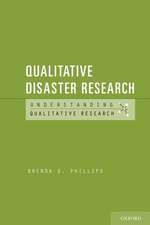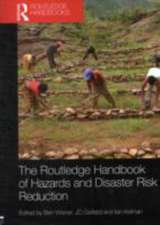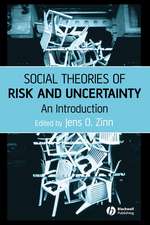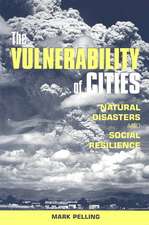The Human Side of Disaster
Autor Thomas E. Drabeken Limba Engleză Hardback – mar 2013
The book begins with a series of original short stories rooted within actual disaster events. These stories are woven into the entire text to demonstrate essential findings from the research literature. Dr. Drabek provides an overview of the range of disasters and hazards confronting the public and an explanation of why these are increasing each year, both in number and scope of impact.
The core of the book is a summary of key findings regarding disaster warning responses, evacuation behavior, initial post-impact survival behavior, traditional and emergent roles of volunteers, and both short-term and longer-term disaster impacts. The theme of "organized-disorganization" is used to illustrate multiorganizational response networks that form the key managerial task for local emergency managers. The final chapter provides a new vision for the emergency management profession—one that reflects a more strategic approach wherein disasters are viewed as non-routine social problems.
This book will continue to be an invaluable reference for professionals and students in emergency management and public policy and aid organizations who need to understand human behavior and how best to communicate and work with the public in disaster situations.
Preț: 602.57 lei
Preț vechi: 842.16 lei
-28% Nou
Puncte Express: 904
Preț estimativ în valută:
115.30€ • 120.38$ • 95.43£
115.30€ • 120.38$ • 95.43£
Carte tipărită la comandă
Livrare economică 04-18 aprilie
Preluare comenzi: 021 569.72.76
Specificații
ISBN-13: 9781466506855
ISBN-10: 1466506857
Pagini: 446
Ilustrații: 2 black & white illustrations
Dimensiuni: 156 x 234 x 25 mm
Greutate: 0.75 kg
Ediția:Revizuită
Editura: Taylor & Francis
Colecția CRC Press
Locul publicării:Oxford, United Kingdom
ISBN-10: 1466506857
Pagini: 446
Ilustrații: 2 black & white illustrations
Dimensiuni: 156 x 234 x 25 mm
Greutate: 0.75 kg
Ediția:Revizuită
Editura: Taylor & Francis
Colecția CRC Press
Locul publicării:Oxford, United Kingdom
Public țintă
Federal, state, and local emergency/disaster management professionals and researchers in domestic and international disasters; high-level undergraduate and graduate students in emergency management, sociology, and public policy programs; international public and private aid non-governmental organizations (NGOs); public policy makers; and government officials involved in emergency planning, operations, and response.Cuprins
Experiences. The Taxi. The Earring. The Honeymoon. The Ceiling. The Regulation. The Exercise. The Insights. The Problem and Approach. The Danger around You Is Increasing. The Approach. The Insights. Hear That Siren? Who Panics and Why. Neutralizing Threat Information. Doing It Right. But Not Everyone Responds the Same. The Insights. It Can’t Be Done. That Lady Named Carla. A Disaster Subculture. The Mythology of Car Wrecks. "Resisters? We Will Arrest Them!". Confirmation: A Likely Action. Families Are the Units. The Insights. Shall We Leave. Pathways to Evacuation. Where Do They Go. "We Wanna Go Home". Evacuation Facilitators. An Aside: Crisis Relocation Planning and Homeland. Security Advisory System. The Insights. Why Me. Victim Responses. The Disaster Syndrome: Another Myth Exploded. Heroes: They Are for Real. Helpers: How Many Are There. "Where Is My Daughter?". But There Are Constraints. The Insights. Volunteers? You Bet! The Flood Breakers. Are Volunteers Like Yachts. The Utopian Mood. Unveiling the Many Forms of Volunteerism. The Insights. Organized Disorganization. Raining in Indianapolis. "But We Deal with Emergencies Daily". Sorting Out Organizational Responders. Is Communication the Problem. Social Map: Lake Pomona Communication Structure. Cooperation Is Not Enough. The Insights. Life in a Fishbowl. The Bitch Phase. Looting Fears. Bad Dreams. Seeking Closure. Short-Term Oscillations. Windows of Opportunity. "When Can We Go Home?" The Insights. What about My Psyche. An Atypical Example. Modal Patterns. Patterned Variations. Kinfolk and Friends. "This Is My Mother". The Insights. What Must Be Done. Variable Perceptions of Risk. Reducing Vulnerabilities. Spread the Risk. Creating a Culture of Preparedness. Disasters Are Nonroutine Social Problems. The Insights. Community Change Agents. Empirical Studies. Professionalism in Emergency Management. An Expanded Vision. Strategies for Maintaining Organizational Integrity. Disaster Response Coordination Strategies. Concluding Principles. Notes. Suggested Readings. Index.
Notă biografică
Thomas E. Drabek is an emeritus professor of sociology and criminology at the University of Denver and continues his research on a part-time basis. His research has examined group and organizational responses to large-scale disasters. Professor Drabek has authored or coauthored over 100 book chapters and journal articles and 28 books. He served as the co-editor of the International Journal of Mass Emergencies and Disasters and was elected president of the International Sociological Association’s Research Committee on Disasters. He prepared four instructor guides for the Emergency Management Institute. In August 2007, Dr. Drabek was the third recipient of the E. L. Quarantelli Award for contributions to social science disaster theory by the International Research Committee on Disasters, and in June 2008, he received the first Dr. B. Wayne Blanchard Award for Academic Excellence in Emergency Management Higher Education. He frequently lectures at academic and emergency management workshops and conventions throughout the United States and around the world.
Descriere
Now in its second edition, this volume is an excellent resource for understanding human behavior and how best to communicate and work with the public in disaster situations. The author uses an informal conversational style to help readers understand the social constraints that guide responses to disaster warnings, initial responses, evacuation decisions, and longer-term impacts. He describes the history of emergency management as well as selected policy issues. Fully updated with new cases and real-world examples, the book continues to be an invaluable reference for professionals in emergency management, aid organizations, and public policy.

























